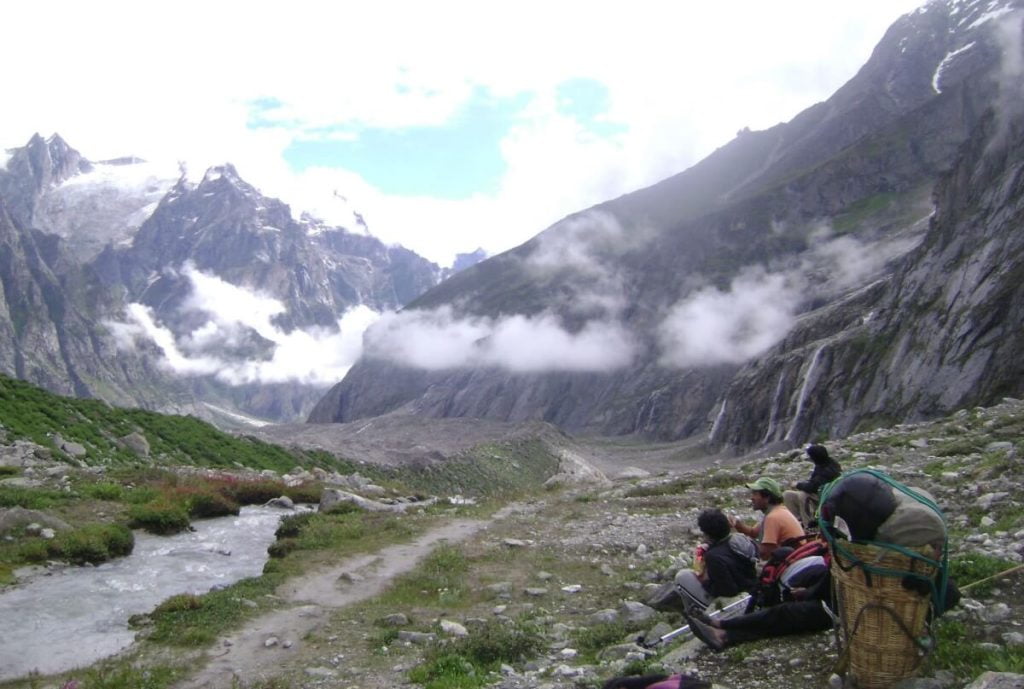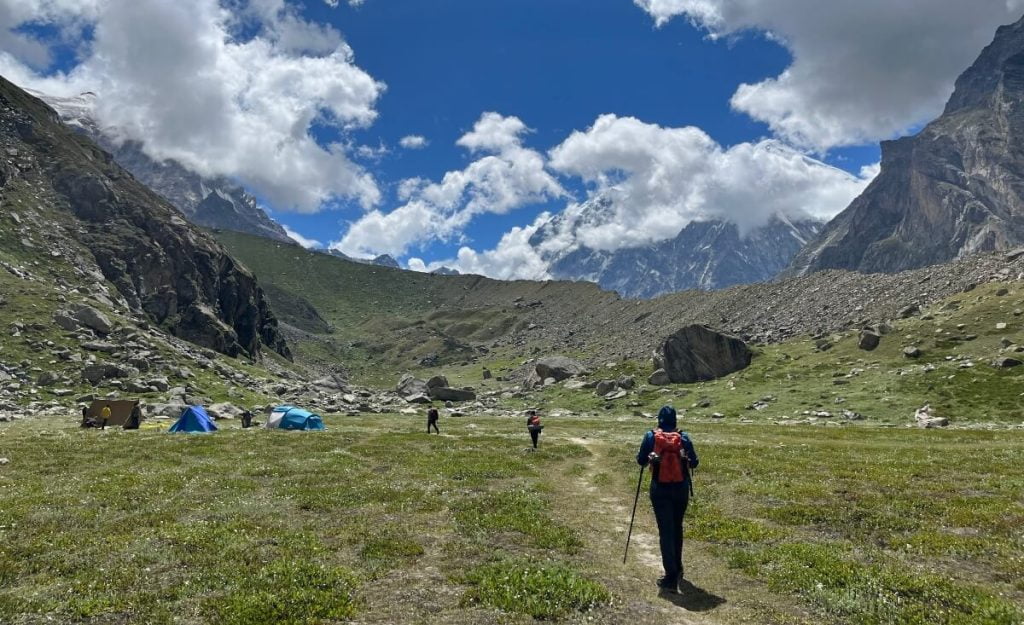Brief About Satopanth Trek
The Satopanth Tal trek is not only a spiritual experience but also offers breathtaking natural beauty. It’s a difficult trek that rewards you with a pristine glacier lake that’s nestled amidst the Garhwal Himalayas. The trek offers stunning views of the snow-covered Chaukhamba peak, Neelkanth peak, and Swargarohini peak. Along the way, you’ll also get to witness the Vasundhara Falls, which is a 400-ft tall waterfall, and Sahastradhara, which has over 100 waterfalls.
The Satopanth Trek is also an opportunity to explore the rich history and culture of the Garhwal region. You’ll get to visit the last village of India, Mana village, and witness ancient temples and historical sites. The trail takes you through thick forests, snow-covered trails, and beautiful meadows, making it a complete package for those seeking adventure, natural beauty, and spiritual fulfillment.
Key details of the Satopanth Trek:
- Ideal Number of Days for the Visit: 7 days and 6 nights
- Trek Distance: 50 km both ways
- Trek Altitude Range: 15,100 feet
- Starting Point: Joshimath
- Nearest Railway Station: Rishikesh Railway Station (300 km)
- Nearest Airport: Jolly Grant Airport, Dehradun (314 km)




Table of Contents
Best Places to Visit during Satopanth Trek
As you trek towards Satopanth Lake, you will be treated to a majestic view of Mount Neelkanth, the highest peak in the Garhwal division of the Himalayas. The mountain can be constantly seen once you cross the Lakshmi van forest region, provided the weather is clear.
Another attraction on the trail is the Vasundhara waterfall, located 3 km from Mana Village. The burbling sound of the falls will accompany you as you trek towards it, and the falls will be visible on your right side on the other bank of the Alaknanda river.
The Satopanth Lake is a crystal-clear, triangular lake surrounded by snow-capped mountains, including the famous Swargarohini, Chawkamba, Neelkanth and Balakun peaks. It remains clean throughout the year, and the lake’s evergreen color soothes the eyes.
If you’re up to visit a good nearby place, Pandukeshwar Temple, located between Joshimath and Badrinath is another great attraction. It is believed to be a sacred place where King Pandu, the father of the great Pandavas of Mahabharata, worshipped Lord Shiva.
What is the best time to visit Satopanth Trek
The Satopanth Tal trek is best undertaken between May to mid-July and September to October. During May to mid-July, the trail is lush with green meadows and wildflowers. Post-monsoon, from September to October, offers the chance to see the Alaknanda river in full flow, along with the Vasundhara waterfalls.
Trekking during the winter season is not possible due to heavy snowfall, while monsoons make the trail dangerous. The best time to visit Satopanth Tal is during May, June, September, and October, with the nearest railhead at Rishikesh and the nearest airport in Dehradun.
How to reach the starting point of the trek?
To reach Satopanth Tal, you need to start your trek from Mana village, which is easily accessible from Haridwar/Rishikesh. If you are coming from cities like Bangalore, Chennai or Mumbai, it is recommended to fly directly to Dehradun and then take a shared taxi or bus to Rishikesh. From Rishikesh, take a bus to Badrinath and stay overnight there. The next day, you can either hire a cab to Mana or directly start the trek from Badrinath.
Alternatively, you can fly to Delhi and take a train or bus to Haridwar, and then follow the same route to Badrinath. It is important to reach Haridwar or Rishikesh by 6 pm and leave for Badrinath the next day at 3 am to reach there by 4 pm. You can then start the trek from Badrinath or hire a cab to Mana.
Availability of accommodations and food near the trek
Food:
Kukke Subrahmanya temple offers plenty of restaurants for an early breakfast before starting your trek, with popular choices like Neo Mysore Cafe and Hotel Kumarakripa opening as early as 5 AM. On the trek itself, Bhatta’s house is the only food source, so let Bhatta know when you arrive to ensure meals are prepared. It’s also a good idea to bring dry fruits, nuts, and non-perishable items like bread and peanut butter or rotis to keep you fueled throughout the two-day trek.
Before setting off, fill your water bottles at one of the temple restaurants, as your next opportunity for water will be at Bhatta’s house or the Forest Office. Carry at least two 1-liter water bottles and avoid filling them from small streams or stagnant sources along the trail, as they might not be safe to drink.
Accommodation:
You can book comfortable resorts and hotels in Joshimath to stay and get ready for the trek.
The Difficulty level of the Satopanth Trek
The Satopanth Tal trek is of moderate-difficult level and requires prior Himalayan trekking experience and high fitness level due to the steep sections on the trail, overall altitude gained, and total distance covered every day. The trail is through a maze of loose rocks, boulders and moraine, and has sections that are steep and need to be negotiated carefully.
The final stretch to Satopanth Tal is quite steep and has loose soil over the glacial moraine. A basic level of physical fitness is recommended, and it is suggested you increase your stamina by doing cardio-vascular exercises like running and swimming. Despite the difficulty, the beautiful view and the beautiful hills all around will continue to delight you.
Is Camping Allowed On Satopanth Trek?
It is recommended to carry your camping equipment for Saropanth Trek. While shops in Badrinath provide camping equipment, the quality is not guaranteed. However, it is possible to rent utensils and other equipment from Badrinath.
Keep in mind that camping on alpine and sub-alpine meadows/grasslands, locally called “Bugyal” is not permitted due to a Uttarakhand High Court order. As a result, camping at Satopanth Tal is not allowed and the highest camp is at Chakratirtha from September 2018 onwards.
Is Any Permission Required For Satopanth Trek?
You need to obtain an inner line permit from the Divisional Forest Office of Nanda Devi Biosphere Reserve in Joshimath. You can get permission by contacting them on 91-1389-222179. If you are hiring a guide, they will help you get the permit.
Nearby Destinations you may want to explore:
- Kedartal Trek in Uttarakhand – Full Travel Guide
- Tarsar Marsar Trek in Kashmir – Full Travel Guide
- 11 Most Amazing Places To Visit in Dalhousie






